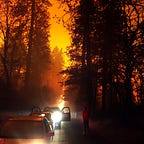What Happens to Lahaina Now?
Two days ago, a wildfire swept out of the hills of Maui and obliterated the city of Lahaina without warning.
That’s something very familiar to me, since I lost my home in the 2018 Camp Fire in Paradise, CA. 47,000 evacuated that day. Nearly 14,000 homes were destroyed. 85 people died.
So I know a little bit about what’s happening to the people of Lahaina. And there are many, many parts to what is happening and will happen to them: food, employment, money, mental health, and maybe someday, recovery are just a few of them.
But I want to talk about housing.
When I was trapped in the Camp Fire, stuck in a line of traffic as far as the eye could see, I realized that the whole town — 30,000+ people — was being evacuated, and that every single one of them would need a place to stay that night.
When I finally got my wife on the phone, the very first thing I said was “Get a hotel room!”
That was the beginning of a very long journey, and housing — shelter — is a huge part of it. The people of Lahaina are just now embarking on that journey.
Geographically, Paradise and Lahaina are very different, so impacts of the fire may differ, but we can still learn a lot from what happened to Paradisians after the Camp Fire. It’s not a happy story.
Post-disaster housing can be divided into 3 parts:
- Immediate or short-term housing
- Mid-term housing
- Long-term or permanent housing
Each has its own unique challenges, and they often run together, but they will be especially challenging for impacted Hawaiians.
First off, where do those 12,000 people sleep tonight? After the Camp Fire, hotel occupancy rates in Sacramento (90 miles away) went from 44% to 99.4% overnight. Maui has lots of hotels, but tourists are in most of those rooms. Without insurance, a hotel room may not be an option.*
Shelters are another (not great) option. After the Camp Fire, nearly every shelter within 50 miles was full. Maui’s limited shelter space is already full.
As a result, ad hoc shelter will end up being a painfully common sight in the coming days. After the Camp Fire hundreds of families set up tents in the Walmart parking lot in Chico.
Something similar is about to happen in Maui.
An entire community sprang up in the Walmart parking lot, but it wasn’t without problems of drugs and sanitation. Ultimately, it was shut down, because ironically, people had nowhere to go. But they couldn’t live there. Sadly, temporary housing all too often becomes permanent housing.
Because Maui is an island, many people won’t be able to leave. Kahului is the largest city on Maui, and it will be heavily impacted by refugees.
Chico, the nearest town to Paradise, saw its population jump by 20% overnight, with all the impacts that suggests.
In Chico, housing prices jumped 44% within weeks of the fire as people raced to get a home.
With a median home price of $1.4 million (according to Realtor.com), such a spike in Maui will be devastating for anyone looking to replace their home.
As a result, people will begin to run out of options. Because Maui is an island, leaving won’t be as easy as just driving away.
A year after the Camp Fire, nearly half of Paradise residents had left the county. It will be harder for the poor of Maui to leave.
But people will be forced to by the lack of housing and the spike in housing prices. Butte County lost over 5% of it’s population after the fire.
The same may happen in Maui, with the same loss of population, funding, and support. Maui will never be the same.
But the expense of leaving Maui will be a barrier to many, leading to Maui’s next crisis: homelessness.
After the Camp Fire, homelessness increased 104% — over double. And homelessness wasn’t temporary. Many people fell into permanent homelessness after the fire.
Maui is in for a world of pain.
In the 5 years since the Camp Fire, only 2,042 of the 14,000 homes that burned have been rebuilt.
The people of Maui need your support. Find a reputable charity and donate.
And get to work building resilience in your own local community.
*If you have decent insurance, one of your coverages will be “Loss of Use”, which means they pay for any additional expenses you incur because you can’t use your home. This is referred to as Additional Living Expenses (ALE — pronounced A-L-E). This would cover the cost of a hotel room, at least for awhile.
